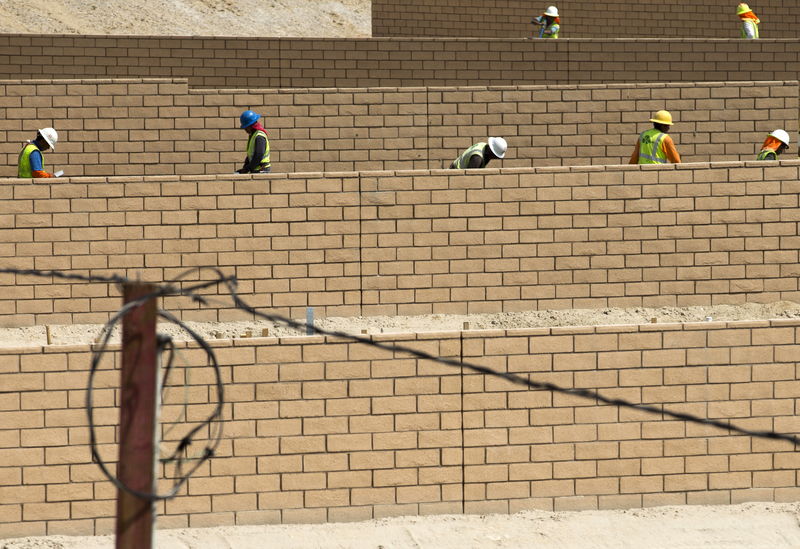By Lucia Mutikani
WASHINGTON (Reuters) - U.S. consumer confidence hit a seven-month high in August and new single-family home sales rebounded in July, suggesting underlying strength in the economy that could still allow the Federal Reserve to raise interest rates this year.
Other data on Tuesday showed moderate gains in house prices in June, which should support consumer spending and keep home purchasing affordable, especially for first-time buyers.
"This is evidence of the 'some further improvement' in the economy that the Fed is waiting for to raise rates. They are so close, they need just a little more confirmation," said Chris Rupkey, chief financial economist at MUFG Union Bank in New York.
The Conference Board said its consumer index jumped 10.5 points to 101.5 this month, the highest reading since January, amid optimism over the labor market. The survey, however, was conducted before a global equity markets sell-off that began last week, which has diminished the chances of a U.S. rate hike next month.
Although sentiment could retreat in September, economists said any decline was likely to be modest. A strong labor market, lower gasoline prices and an improving housing market also are seen supporting consumer confidence.
The survey's so-called labor market differential, which closely correlates to the unemployment rate in the employment report, was the most favorable since January 2008.
The share of consumers expecting an increase in incomes slipped, but fewer anticipated a decline.
"If this upbeat sentiment is sustained, then it could potentially provide a strong platform for a sustained upswing in consumer spending activity, which could provide a strong tailwind for the economic recovery going forward," said Millan Mulraine, deputy chief economist at TD Securities in New York.
In a separate report, the Commerce Department said new home sales increased 5.4 percent to a seasonally adjusted annual rate of 507,000 units. Those sales, which account for 8.3 percent of the market, were up 25.8 percent compared to July of last year.
The reports, which added to a steady stream of data that have painted an optimistic picture of the U.S. economy, helped boost U.S. stocks, which enjoyed their biggest rally of the year before surrendering the gains and ending lower.
Market sentiment also was supported by China's second interest rate cut in the past two months. The dollar rose against a basket of currencies, while prices for U.S. government debt fell.
GAINING STEAM
The prospects of a U.S. rate hike next month already had been dealt a blow before the recent global markets turmoil, with the minutes of the Fed's July 28-29 policy meeting highlighting policymakers' concerns about persistently low inflation.
"We think that the Fed will not raise rates in September, they need a little time to digest what has happened and we think they will raise in December," said Chris Christopher, an economist at IHS Global Insight in Lexington, Massachusetts. "Prior to Friday, we thought that the Fed would raise rates in September."
New home sales rose in three of the four U.S. regions last month, touching a 14-month high in the Northeast.
The housing market is gaining steam, with data last week showing home resales jumped to a near 8-1/2-year high in July and groundbreaking on new home building climbing to its highest level since October 2007.
The recovery in the sector, which touches almost all spheres of the economy, is being driven by the tightening labor market. A third report showed the S&P/Case Shiller composite index of 20 metropolitan areas in June gained 5.0 percent year-over-year compared to a gain of 4.9 percent in May.
"If the pace of appreciation stabilizes around current levels, it could provide enough incentive to encourage homeowners to put their homes on the market, while encouraging potential homebuyers back into the market," said Lewis Alexander, chief economist at Nomura in New York.
The sturdy housing market is boosting homebuilders. Toll Brothers (N:TOL), the largest U.S. luxury home builder, said on Tuesday that orders had risen 16 percent so far in the quarter started in August, outpacing the 12 percent rise in the company's third quarter.
The Commerce Department said the stock of new houses for sale increased 1.9 percent to 218,000 last month, the highest level since March 2010. Still, supply remains less than half of what it was at the height of the housing boom.

At July's sales pace it would take 5.2 months to clear the supply of houses on the market, down from 5.3 months in June.